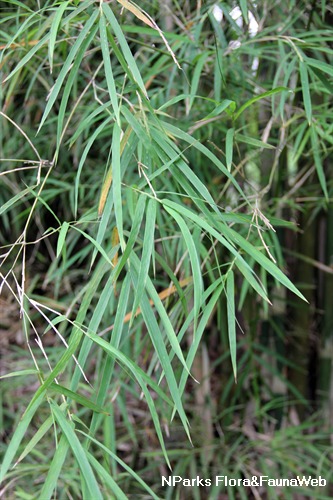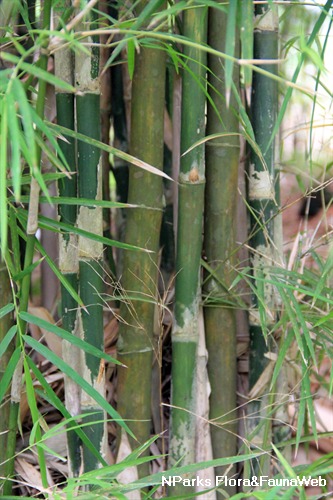
Back
Thyrsostachys siamensis Gamble
| Family Name: | Poaceae (Gramineae) |
| Synonyms: | Acroceras regia, Bambusa siamensis, Bambusa regia |
| Common Name: | Monastery Bamboo, Temple Bamboo, Thailand Bamboo, Umbrella Handle Bamboo |
Name
Classifications and Characteristics
| Plant Division | Angiosperms (Flowering Seed Plants) (Monocotyledon) |
|---|---|
| Plant Growth Form | Shrub, Grass or Grass-like Plant |
| Lifespan (in Singapore) | Perennial |
| Mode of Nutrition | Autotrophic |
| Plant Shape | Columnar |
| Maximum Height | 7 m to 13 m |
Biogeography
| Native Distribution | Myanmar to Indochina |
|---|---|
| Native Habitat | Terrestrial (Monsoon Forest) |
| Preferred Climate Zone | Sub-Tropical / Monsoonal |
Description and Ethnobotany
| Others - Plant Morphology | Growth Form: Deciduous bamboo forms erect, tight clumps that emerge from rhizomes. Habitat: Found in monsoonal climates at altitudes from 0 - 400 m. Occurs in dry deciduous forests in either pure or mixed stands. Stems: It has strong, nearly solid erect stems known as culms (7 - 13 m long, 2 - 6 cm wide). The internodes (the area between points of leaf attachment to the culm) are 15 - 30 cm apart. The culm is mostly light green with thin, white bands underneath the nodes where leaves are attached. The papery remainder of triangular culm sheaths surround the culm above the nodes. Foliage: Each branch produces about 4 - 12 linear, pointed leaves (7 - 15 cm long, 0.6 - 1.2 cm wide). Leaves are light green with entire leaf margins. Flowers: The inflorescence consists of a highly branched set of spikelets (tiny, stalkless flowers borne along one small, main axis). Flowering occurs unpredictably, sometimes at intervals up to 40 years. Fruits: Beaked fruits are small and cylindrical (0.5 cm long, 0.3 cm wide). Landscaping: The narrow leaves of this species are easily rustled by the wind, creating an elegant, peaceful atmosphere. This species is ideal for screening, because it forms erect, tight clumps. A small clump could be planted in gardens for an attractive, Asian look. It is often planted in containers to decorate monasteries in Thailand. Cultivation: This species grows best on fertile, well-drained soil. However, it is tolerant of nutrient poor soils. Propagation: Propagate by seed, culm cutting (similar to a stem cutting) or rhizome division. Etymology: The genus "Thyrsostachys" is derived from the Greek words for stalk ("thursos") and head of grain ("stachus"). It refers to the grain-like appearance of the inflorescence. The species epithet "siamensis" is a reference to Thailand as this species's country of origin. Siam was the old name of Thailand. The common name "Monastery Bamboo" comes from the fact that it is often planted around monasteries in Thailand. It was also named "Umbrella Handle Bamboo," because the culms are used to make umbrella handles, as well as other handicrafts. Nomenclature: The taxonomically correct name for this species is Thyrsostachys regia, but it is widely known as Thyrsostachys siamensis in Southeast Asia. Some botanists support the use of Thyrsostachys siamensis due to its widespread use. |
|---|---|
| Ethnobotanical Uses | Food (Fruit or Vegetable) Others: Food: Young shoots are edible. They are added to Asian stirfrys or soups. Other: The stems (known as culms) are used to construct houses, furniture, fences and decorative objects. The pulp can also be used to make paper. It is sometimes used as a windbreak to protect cropland from soil erosion. |
Landscaping Features
| Desirable Plant Features | Ornamental Foliage, Ornamental Stems |
|---|---|
| Landscape Uses | General, Hedge / Screening, Container Planting |
| Thematic Landscaping | Zen / Minimalist Garden |
Fauna, Pollination and Dispersal
| Seed or Spore Dispersal | Abiotic |
|---|
Plant Care and Propagation
| Light Preference | Full Sun, Semi-Shade |
|---|---|
| Water Preference | Moderate Water |
| Rootzone Tolerance | Fertile Loamy Soils, Well-Drained Soils, Poor Infertile Soils |
| Propagation Method | Seed, Stem Cutting, Division |
Foliar
| Foliage Retention | Deciduous |
|---|---|
| Mature Foliage Colour(s) | Green |
| Mature Foliage Texture(s) | Smooth |
| Foliar Type | Simple / Unifoliate |
| Foliar Shape(s) | Non-Palm Foliage (Linear) |
| Foliar Venation | Parallel |
| Foliar Margin | Entire |
| Foliar Apex - Tip | Acute |
| Foliar Base | Rounded / Obtuse |
| Typical Foliar Area | Microphyll ( 2.25cm2 - 20.25 cm2 ) |
Non - Foliar and Storage
| Stem Type & Modification | Cane |
|---|---|
| Root Type | Underground (Fibrous Root) |
| Specialised Storage Organ(s) | Underground (Rhizome) |
Fruit, Seed and Spore
| Fruit Classification | Simple Fruit |
|---|---|
| Fruit Type | Indehiscent Dry Fruit , Caryopsis / Grain |
Image Repository
Others
| Master ID | 30482 |
|---|---|
| Species ID | 4791 |
| Flora Disclaimer | The information in this website has been compiled from reliable sources, such as reference works on medicinal plants. It is not a substitute for medical advice or treatment and NParks does not purport to provide any medical advice. Readers should always consult his/her physician before using or consuming a plant for medicinal purposes. |



